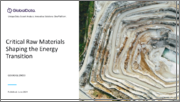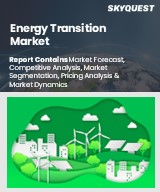
|
시장보고서
상품코드
1511597
에너지 전환을 형성하는 중요 재료Critical Materials Shaping Energy Transition |
||||||
세계의 에너지 전환에 수반하여 태양광, 풍력, 에너지 저장, 전기자동차, 저탄소 수소 생산 등의 주요 기술에서 대폭적인 생산능력 증강이 필요합니다. 이에 따라 광범위한 중요 재료의 수요가 증가하며, 일부 재료에서는 수요 성장이 공급을 웃돌게 됩니다.
에너지 전환 기술로 인해 수요가 크게 증가할 것으로 예상되는 원자재는 다음과 같습니다. 최근 공급과잉 우려에도 불구하고, 리튬은 장기적으로 가장 위험도가 높은 중요한 원자재임에 틀림없으며, 에너지 밀도 특성으로 인해 배터리 전기자동차(BEV)와 에너지 저장에 사용되는 매우 중요한 원자재입니다. 광산업체들이 생산 능력을 늘리면서 광산측 공급 리스크는 줄어들고 있으나 리튬 정제는 여전히 중국과 같은 특정 국가에 지역적으로 집중되어 있으며, 밸류체인의 가공 요소에 단일 공급원 리스크를 초래하고 있습니다.
한편, 코발트, 구리, 니켈, 흑연과 같은 다른 원자재들은 에너지 전환 기술에 어떤 영향을 미칠 수 있는지에 대해 중-첨단 리스크가 지속될 것으로 보입니다. 풍력, 태양광, 전력망, 에너지 저장, 전기자동차 등의 기술에는 대량의 재료가 필요하기 때문에 신규 광산 개발이 진행되는 동안 기존 공급에 압박을 가할 수 있습니다.
백금과 실리콘과 같은 재료는 에너지 전환의 위험이 중간에서 낮은 수준이지만, 장기적으로 두 재료 모두 수요가 크게 증가할 것이기 때문에 공급을 확보하기 위한 국제적인 노력이 필요합니다. 전해질막 전해조가 수소 생산에 광범위하고 빠르게 채택되면 백금 공급을 위협할 수 있습니다. 한편, 실리콘은 태양전지의 중요성에도 불구하고 여전히 지역적으로 가장 집중된 공급망 중 하나입니다.
주요 하이라이트
- 최근 재생에너지와 지원 인프라의 개발 증가에 수반하여 주요 광물의 수요가 대폭 증가하고 있습니다.
- IEA에 따르면 청정에너지 기술에 의한 광물 수요는 2010년 460만 톤에서 2020년에 710만 톤으로 증가하며, 이 기간의 CAGR은 4.3%였습니다.
- GlobalData의 광물 생산 예측에 따르면 리튬 생산은 2024-2030년에 CAGR로 14%의 성장이 전망되며, 이 10년의 말에는 500kT를 넘을 것으로 예측됩니다.
- 리튬이온 배터리에 의존하는 에너지 저장 프로젝트는 2023-2010년말에 대폭적인 증가가 전망되고 있으며, 이 서브 테크놀러지 에너지 저장 용량은 많은 파이프라인 프로젝트가 가동하는 것에 따라 2023년 18GWh에서 2030년까지 54GWh로 증가합니다.
- 칠레는 구리를 주요 광물로 하는 97개의 광산 프로젝트 파이프라인으로 세계의 구리 산업에서 강력한 시장 포지션을 유지할 것이며, 페루, 미국, 캐나다 , 호주 등의 기타 국가도 향후 예정되어 있는 구리 광산의 장소로서 인기가 있을 것으로 생각됩니다.
- 중국은 솔라 밸류체인의 각 단계를 독점하고 있으며, 규소의 주요 생산국으로서 2024년에 연간 600만 톤의 생산 능력이 예측됩니다. 중국은 패널 및 모듈의 제조와 함께 웨이퍼와 셀에서도 주요 생산국입니다.
에너지 전환을 형성하는 중요 재료에 대해 조사분석했으며, 각 재료의 리스크 평가, 수급 예측, 현재와 향후 프로젝트의 상세 정보 등을 제공하고 있습니다.
목차
- 주요 요약
- 에너지 전환과 중요 원재료
- 리튬
- 구리
- 코발트
- 니켈
- 백금
- 규소
- 흑연
- 문의
The global energy transition will require a substantial build out of capacity across key technologies such as solar, wind, energy storage, electric vehicles and low-carbon hydrogen production. This will increase demand across a broad range of critical materials and for some this demand growth will outpace supply. In its critical minerals report, GlobalData identifies the most at-risk raw materials necessary for the energy transition, taking into account the importance of each material to different energy transition technologies, the volume of material required, and risk factors to each material's supply. Using this framework, the report discusses the supply risk of lithium, cobalt, copper, nickel, platinum, silicon, and graphite.
The raw materials discussed will experience significant demand increases from energy transition technologies. Despite recent oversupply concerns, lithium arguably remains the most at-risk critical raw material for the long term, with its energy density properties making it a pivotal raw material for battery electric vehicles (BEVs) and energy storage more widely. Although miners are increasing their production capacity, which will alleviate the mine side supply risk, lithium refining remains highly geographically concentrated in select countries such as China, creating single source risk in the processing element of the value chain.
Meanwhile, other raw materials such as cobalt, copper, nickel, and graphite, will continue to have a medium-high level of risk in terms of how they could impact energy transition technologies. Large quantities of each material will be required for technologies such as wind, solar, power grids, energy storage, and electric vehicles, which will put pressure on existing supplies while new mines continue to develop.
Materials such as platinum and silicon present a medium to low risk for the energy transition but still require international efforts to secure their supplies as both will face a strong increase in demand in the long term. A widespread and rapid adoption of PEM electrolyzers within hydrogen production will threaten platinum supplies while, despite its importance to solar, silicon still holds one of the most geographically concentrated supply chains.
Key Highlights
- Recent years have witnessed a strong increase in demand for key minerals following the increased installation of renewable energy and its supporting infrastructure.
- According to the IEA, mineral demand from clean energy technologies increased from 4.6Mt in 2010 to 7.1Mt in 2020, which represented a CAGR of 4.3% across the time frame.
- According to GlobalData's commodity production forecasts, lithium production is expected to increase at a CAGR of almost 14% between 2024 and 2030, surpassing 500kT by the end of the decade.
- Although alternative battery chemistries are increasingly a focus of research and development efforts, energy storage projects relying on lithium-ion batteries are still expected to see a strong increase between 2023 and the end of the decade, with the energy storage capacity of this sub-technology increasing from 18GWh in 2023 to 54GWh by 2030 as a number of pipeline projects come online.
- While Chile will retain its strong market position in the global copper industry with a pipeline of 97 mine projects where copper is the primary commodity, other countries such as Peru, the United States, Canada, and Australia will also be popular sites for upcoming copper mines.
- China dominates each stage of solar value chain, acting as a leading producer of silicon, with a forecast production capacity of 6mtpa in 2024. China is also a pre-eminent player within wafer, cell, as well as panel and module manufacturing.
Scope
- Risk assessment of critical raw materials required for energy transition technologies
- Risk drivers for critical material value chains
- Lithium supply and demand forecasts
- Lithium active and upcoming mines
- Energy transition technologies driving increased lithium demand
- Analysis of leading countries and companies for lithium
- Copper supply and demand forecasts
- Analysis of upcoming copper projects by geography and development stage
- Analysis of leading countries and companies for copper
- Cobalt supply and demand forecasts
- Project details for largest active and upcoming cobalt mines
- Analysis of leading countries and companies for cobalt
- Nickel supply and demand forecasts
- Project details for largest active and upcoming nickel projects
- Analysis of leading countries and companies for nickel production
- Platinum supply and demand forecasts
- Project details for largest active and upcoming platinum projects
- Analysis of leading countries and companies for platinum production
- Silicon supply and demand analysis
- Top silicon producing countries
- Graphite supply and demand analysis
- Project details for largest active and upcoming graphite projects
- Leading countries and companies for graphite production
Reasons to Buy
- Understand the factors driving risk for the supplies of critical materials necessary for the energy transition.
- Gain an understanding of the critical material demands of energy transition technologies.
- Stay informed about key mining projects that will influence the supplies of critical raw materials
- Gain insight into the geographical characteristics of the critical raw material market
- Understand the key players producing lithium, cobalt, copper, nickel, platinum and graphite.
Table of Contents
Table of Contents
- Executive Summary
- The Energy Transition and Critical Raw Materials
- Lithium
- Copper
- Cobalt
- Nickel
- Platinum
- Silicon
- Graphite
- Contact Us


















